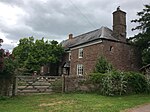Hilston Park

Hilston Park is a country house and estate between the villages of Newcastle and Skenfrith in Monmouthshire, Wales, close to the border with Herefordshire, England. The house and park are in the Monnow valley, beside the B4347 road, 7.9 miles (12.7 km) by road northwest of Monmouth and just over 1 mile (1.6 km) southwest of Skenfrith. The Palladian mansion, built in 1838 for Bristolian banker George Cave, is a Grade II* listed building, the grounds and landscape park are registered on the Cadw/ICOMOS Register of Parks and Gardens of Special Historic Interest in Wales and the park's flower meadow is a Site of Special Scientific Interest. The park includes an early 20th century lodge at each of the two entrance gates; a ruined coach house; a lake, boathouse, and pond; several streams, gardens, and wooded areas; and Hilston Tower, a late 18th-century folly of red sandstone in the grounds's northeastern corner. The house served as a residential outdoor education centre, operated by Gwent Outdoor Centres and supported by the local authorities of Newport, Torfaen, Blaenau Gwent and Monmouthshire until 2019. In 2020, the councils decided to consolidate their outdoor education facilities on a single site, and Hilston Park was deemed surplus to requirements. The house was sold at auction in 2021.
Excerpt from the Wikipedia article Hilston Park (License: CC BY-SA 3.0, Authors, Images).Hilston Park
B4347,
Geographical coordinates (GPS) Address Nearby Places Show on map
Geographical coordinates (GPS)
| Latitude | Longitude |
|---|---|
| N 51.864444444444 ° | E -2.805 ° |
Address
B4347
NP25 5NW , Whitecastle
Wales, United Kingdom
Open on Google Maps










